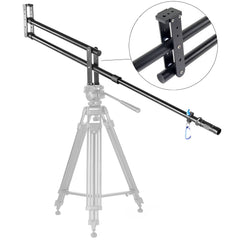Crane Essentials - Camera Cranes
Camera Crane / Camera Jib

In cinematography, a jib or crane is a boom device with a camera on one end, and a counterweight and control and monitoring equipment on the other. In the following discussion the word crane can be 100% interchanged with jib or boom.
A crane is a mechanical tool used to elevate, swing, tilt and pan a camera by mounting it on the end of a jib. Camera Cranes provide the camera operator with a simple, easy to use, cost effective tool for putting your camera in motion and achieving a variety of angles and positions that are not usually easily obtained. While cranes can be used to simply position a camera in a remote place, their real strength is in moving the camera during the shot providing a moving perspective for the audience. There are a wide variety of cranes built for a wide variety of situations.
Jibs made of strong and light material such as carbon fiber and aluminum are usually more expensive than jibs built with steel, but are considerably lighter and easier to transport. However there is a trade off. When moving the jib there are a variety of forces affecting the camera move you are trying to achieve. Having a heavier crane, usually provides a slower and smoother movement, thus more dramatic.
What types of Jibs are available:
| Simple Action Rectangular Jibs. These cranes generally use two bars, one on top of the other with two parallel, but pivot-able mounting points. As the crane booms the camera can stay pointed at the subject throughout the arc of the boom. If you move the top bar forward or the bottom bar back you can tilt the camera, although the crane does tend to move when tilted. Varizoom, iFootage, ProAm and Came build parallel type cranes. In general, these are usually inexpensive, made of aluminum or carbon fiber tubes with aluminum mounts and pivots |  |
| Remote Head Cranes are cranes that require a remote pan and tilt head to provide camera movement functions at the camera end of the crane. While swing and boom are still done at the operator level. These cranes are usually quite heavy duty and considerably more costly than others as the pan and tilt head add in most cases are more expense than the crane itself. Jimmy jibs, Eurocranes and Porta-Jibs are examples of these types of cranes. In many cases these cranes also provide seating and controls for an operator at the Boom operator area. These are the more expensive cranes. |  |
| Cable Assist Cranes, like Varavon, Hauge and CobraCrane rely on the fluid head to dampen the tilting and panning of the crane, thus allowing them to benefit from the variable fluid drag on both the pan and tilt. This provides for smooth, dramatic moves with little effort. In many cases the cable also provides the ability to control the camera tilt independently of the boom, as well as provide a method for keeping the camera pointed at the subject throughout the arc of the boom. Like all other cranes, these cranes require remote control for monitoring and camera control at the operator's standing position. Generally these cranes are the most cost effective to buy, and less expensive overall to operate. |  |
Crane Usage:
Recently we published a guide to show how camera cranes are used as well as some examples of their use in popular movies. You can find that guide here: SchoolVideoNews camera Crane.
Other applications of camera cranes outside of making a movie include:
Sporting events and concerts:


Large area events such as parades and parties where getting a un-obstructive view is a priority such as the red carpet at the Oscars.

Other applications include medical and training applications where you want the camera to be able to see angles that would otherwise be tough to shoot, such as shooting over a medical procedure, or showing students how to work on small products. Or as a tool for training videos.

Crane Application
The following discussion goes into details on things to consider when choosing a crane for your work. What shots will benefit from the use of a crane. Will you use the crane to get high shots or do you use the crane to get dramatic motion? Will I be using the crane indoors or out or both? Will it fit and be effective where I want to shoot>? So ask these types of questions. If you are shooting real estate in doors, well then a small, lightweight and easy to maneuver system will be good. Shooting over a crowd? Almost all cranes are long enough to shoot over a crowd. Do I need to get very high shots? If not really, then smaller, lighter cranes will be more effective for you. Can I get the high shots with a more appropriate aerial device? IF so, then a small crane is more important.
Cranes are not yet replaced by drones. They both have their strengths and weaknesses. A drone is lightweight and quite agile and of course can go where no crane has been before, however it is usually taxed by weight. This means that you are restricted to using lighter, smaller cameras with a small wireless control and monitoring system. In cases where you want shots covering a lot of area, you simply have to make compromises based on your weight restrictions as well as flight restrictions, such as tight areas, school and dwelling restrictions and of course in doors.
With a crane you can work indoors, use less expensive wired remote controls and monitors, plug into ac electricity and generally get better shots simply because you can use a bigger lens and not be restricted to battery life and bad weather. Either way, you may find you need both. For those who specialize or spend most of their time in the wilderness or in the skies, then a drone may be the way to go first, for most others a crane will get a maximum benefit at a much lower cost to acquire and considerably less expensive to operate over time. Remember a small cheap drone is not gonna be able to support a heavier lens and body. However the drones that do support those cameras and the gimbals, batteries and wireless gear are a considerably larger investment. Coincidently drone technology is getting better very quickly and like my computer, I dont really want to replace or even feel like I have yesterday's technology today. Cranes on the other hand are pretty much all still in operation. So long term cranes make a lot of sense.
Learning Curve:
One of the most pleasing aspects of a using a crane is the quick return on our time investment. Meaning you can quickly get a considerably better shot as soon as you start to use a crane. With only minutes of practice we have got the essential mechanics understood and we become comfortable with the controls very quickly. One of the things that we really enjoy is seeing the results of the first shot and the smile on the faces of the shooter. The instant satisfaction in self worth alone makes it a great addition to your toolbox.
Size, Weight, Height
Certainly one of the main considerations of your crane is the size of the crane. Crane size is pretty much proportional to crane weight and to the size of the largest components, meaning that if you purchase a long crane, well they are probably gonna be considerably heavier than a light one. The longer the crane is between the pivot and the camera, the more counterweight its gonna require and the more stable platform it will need. However with cranes it is important to consider the trade offs more intently.
If you shoot on site, transportation is a factor and within that factor is both weight for carrying as well as dimensions Will this crane fit in the vehicle I want to transport it with? Will it fit in our storage area? Can I physically carry it? Do I need a helpers to carry and install? Do I need machinery or dolly maybe, to move it to the location. When shooting onsite will I bring my own counterweights or will I use weight bags and fill it with materials on site or tools I will be carrying. Small cranes allow you to counterweight locally. Larger, longer cranes require lots of weight and in most cases, needs to be shlepped on site.
 Transporting a large crane can be a huge challenge. Make sure you have the proper equipment to transport and safely store your equipment. In so many cases a small 8 foot crane can serve the exact same purpose as the giant MovieBird. Remember its not the size of the crane, but the the way it is being used. Creating realistic methods to obtain challenging shots. Have Fun and be creative!
Transporting a large crane can be a huge challenge. Make sure you have the proper equipment to transport and safely store your equipment. In so many cases a small 8 foot crane can serve the exact same purpose as the giant MovieBird. Remember its not the size of the crane, but the the way it is being used. Creating realistic methods to obtain challenging shots. Have Fun and be creative!
